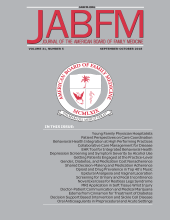Research ArticleOriginal Research
The Decision to Intensify Therapy in Patients with Type 2 Diabetes: Results from an Experiment Using a Clinical Case Vignette
Richard W. Grant, Karen E. Lutfey, Eric Gerstenberger, Carol L. Link, Lisa D. Marceau and John B. McKinlay
The Journal of the American Board of Family
Medicine September 2009, 22 (5) 513-520; DOI: https://doi.org/10.3122/jabfm.2009.05.080232
Richard W. Grant
MD, MPH
Karen E. Lutfey
PhD
Eric Gerstenberger
MS
Carol L. Link
PhD
Lisa D. Marceau
MPH

References
- ↵American Diabetes Association. Standards of medical care in diabetes—2008. Diabetes Care 2008; 31(Suppl 1): S12–S54.
- ↵Nathan DM, Buse JB, Davidson MB, et al. Management of hyperglycemia in type 2 diabetes: a consensus algorithm for the initiation and adjustment of therapy: a consensus statement from the American Diabetes Association and the European Association for the Study of Diabetes. Diabetes Care 2006; 29: 1963–72.
- ↵Chobanian AV, Bakris GL, Black HR, et al. The Seventh Report of the Joint National Committee on Prevention. Detection, Evaluation, and Treatment of High Blood Pressure. JAMA 2003; 289: 2560–72.
- ↵Intensive blood-glucose control with sulphonylureas or insulin compared with conventional treatment and risk of complications in patients with type 2 diabetes (UKPDS 33). UK Prospective Diabetes Study (UKPDS) Group. Lancet 1998; 352: 837–53.
- ↵Yusuf S, Sleight P, Pogue J, Bosch J, Davies R, Dagenais G. Effects of an angiotensin-converting-enzyme inhibitor, ramipril, on cardiovascular events in high-risk patients. The Heart Outcomes Prevention Evaluation Study Investigators. N Engl J Med 2000; 342: 145–53.
- ↵Grant RW, Buse JB, Meigs JB. Quality of diabetes care in US academic medical centers: low rates of medical regimen change. Diabetes Care 2005; 28: 337–442.
- ↵Shah BR, Hux JE, Laupacis A, Zinman B, van Walraven C. Clinical inertia in response to inadequate glycemic control: do specialists differ from primary care physicians? Diabetes Care 2005; 28: 600–6.
- ↵Rodondi N, Peng T, Karter AJ, et al. Therapy modifications in response to poorly controlled hypertension, dyslipidemia, and diabetes mellitus. Ann Intern Med 2006; 144: 475–84.
- ↵Berlowitz DR, Glickman M, Ash AS, Friedman R, Hickey EC, Kader B. Hypertension management in patients with diabetes. Diabetes Care 2003; 26: 355–9.
- ↵Safford MM, Shewchuk R, Qu H, et al. Reasons for not intensifying medications: differentiating “clinical inertia” from appropriate care. J Gen Intern Med 2007; 22: 1648–55.
- Parchman ML, Pugh JA, Romero RL, Bowers KW. Competing demands or clinical inertia: the case of elevated glycosylated hemoglobin. Ann Fam Med 2007; 5: 196–201.
- Grant RW, Adams AS, Trinacty CM, et al. Relationship between patient medication adherence and subsequent clinical inertia in type 2 diabetes glycemic management. Diabetes Care 2007; 30: 807–12.
- ↵Perlin JB, Pogach LM. Improving the outcomes of metabolic conditions: managing momentum to overcome clinical inertia. Ann Intern Med 2006; 144: 525–7.
- ↵Fang MC, McCarthy EP, Singer DE. Are patients more likely to see physicians of the same sex? Recent national trends in primary care medicine. Am J Med 2004; 117: 575–81.
- Bach PB, Pham HH, Schrag D, Tate RC, Hargraves JL. Primary care physicians who treat blacks and whites. N Engl J Med 2004; 351: 575–84.
- Hasnain-Wynia R, Baker DW, Nerenz D, et al. Disparities in health care are driven by where minority patients seek care. Arch Intern Med 2007; 167: 1233–88.
- ↵Feldman HA, McKinlay JB, Potter DA, et al. Nonmedical influences on medical decision making: an experimental technique using videotapes, factorial design, and survey sampling. Health Serv Res 1997; 32: 343–66.
- Peabody JW, Luck J, Glassman P, Dresselhaus TR, Lee M. Comparison of vignettes, standardized patients, and chart abstraction: a prospective validation study of 3 methods for measuring quality. JAMA 2000; 283: 1715–22.
- McKinlay JB, Lin T, Freund K, Moskowitz M. The unexpected influence of physician attributes on clinical decisions: results of an experiment. J Health Soc Behav 2002; 43: 92–106.
- ↵Strauss A, Corbin J. Basics of qualitative research: grounded theory procedures and techniques. Newbury Park, CA: Sage; 1990.
- ↵Schulman KA, Berlin JA, Harless W, et al. Correction: The effect of race and sex on physicians’ recommendations for cardiac catheterization. N Engl J Med 1999; 340: 618–26.
- ↵Lutfey KE, Campbell SM, Renfrew MR, Marceau LD, Roland M, McKinlay JB. How are patient characteristics relevant for physicians’ clinical decision making in diabetes? An analysis of qualitative results from a cross-national factorial experiment. Soc Sci Med 2008; 67: 1391–9.
In this issue
The Journal of the American Board of Family
Medicine
Vol. 22, Issue 5
September-October 2009
The Decision to Intensify Therapy in Patients with Type 2 Diabetes: Results from an Experiment Using a Clinical Case Vignette
Richard W. Grant, Karen E. Lutfey, Eric Gerstenberger, Carol L. Link, Lisa D. Marceau, John B. McKinlay
The Journal of the American Board of Family
Medicine Sep 2009, 22 (5) 513-520; DOI: 10.3122/jabfm.2009.05.080232
The Decision to Intensify Therapy in Patients with Type 2 Diabetes: Results from an Experiment Using a Clinical Case Vignette
Richard W. Grant, Karen E. Lutfey, Eric Gerstenberger, Carol L. Link, Lisa D. Marceau, John B. McKinlay
The Journal of the American Board of Family
Medicine Sep 2009, 22 (5) 513-520; DOI: 10.3122/jabfm.2009.05.080232
Jump to section
Related Articles
Cited By...
- Barriers to effective management of type 2 diabetes in primary care: qualitative systematic review
- Effective Use of Structured Self-Management of Blood Glucose in Type 2 Diabetes: Lessons From the STeP Study
- Why system inertia makes health reform so difficult
- On Postpartum Depression, Hormonal Problems, and Practice Management for Medical Home Implementation
- Guest Family Physician Commentaries





